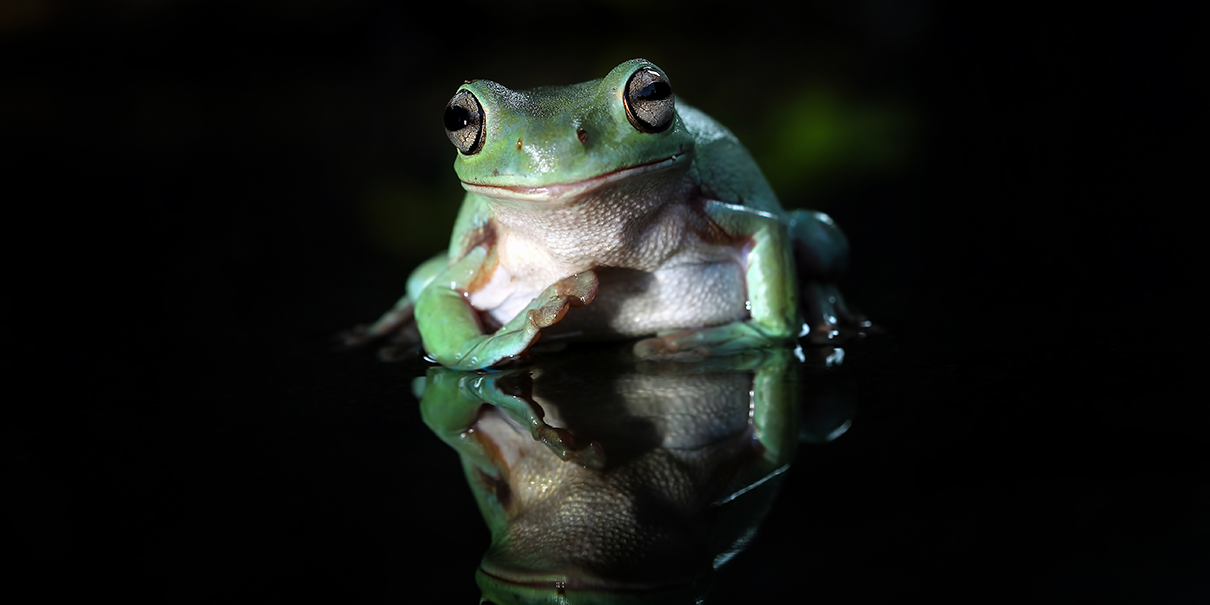
Everything You Need To Know About Frog Care
General Advice
Health and Wellbeing
Reptile
01/05/2023
I have been keeping frogs for more than six years now. I own Green and Golden Bell frogs, Southern Bell frogs and little Whistling Tree frogs, which are the three species that are available to keep as pets in New Zealand. They were all introduced into the country in the nineteenth century.
My passion for frogs started when I was a child - they are so fascinating and they have their own personalities. Most of my frogs were raised from tadpoles, which probably explains why they are so confident around me. Having quickly learned that I am their food source, they watch me to see what’s for lunch. Each of my frogs have their favourite spots in their enclosure and can get quite protective off their special places.
Do your research before buying a frog
Before you buy frogs, research their needs and have their enclosure and food ready. It’s very important to make sure they are lively and healthy – if they are skinny and lethargic, this could be a sign of illness. Ask if they are wild caught or captive bred. I personally do not like the thought of taking established frogs from their natural environment, but if they have been, make sure they are not one of the native species of frog, which are protected. You must also never release captive frogs into the wild – not only is this illegal but you would be putting the health of our native frogs at risk.
Bringing your frog home
Once you have bought your frog home, you may notice that it’s not interested in eating initially and will hide for a few days. This is quite normal behaviour, as it takes time for your frog to settle into its new environment. Before you introduce a new frog to your exisiting frogs, keep it quarantined in a separate enclosure for 30 days first. This is very important as the new frog may have an illness that could be passed onto your other frogs. Also, you should never mix different frog species in the same enclosure, as they can infect each other with bacteria, toxins and parasites.
Choosing the right enclosure for your frog
I have both indoor and outdoor enclosures for my frogs. My two adult Green and Golden Bell frogs live in a 60x45x45cm enclosure, which is a satisfactory size for them, although the bigger their enclosure the better. For my four Southern Bell frogs, home is an outdoor froggery that measures 2x1.5m.Along with the Whistling Tree frogs, they do well outside in Christchurch where I live, but it’s too cold outside for the Green and Golden Bell frogs.
It’s best to put a layer of small rocks on the bottom of the enclosure. Don’t use gravel or small stones that can fit into your frog’s mouth as they could accidently be swallowed while your pet is eating. I put potted plants in with the rocks to support the pots and make sure the rocks are about the height that I want the water level to be. On top of the rocks I place Sphagnum moss and then creeping mosses on the top of that.
Fake logs and large rocks are perfect for keeping the stones secure and establishing a pond area. If you are not keen on a large water area, you can just have a container of water. But make sure your frog is able to get in and out of the water container by supplying a rock or driftwood that it can climb on and then jump off. Frogs will drown if they can’t get out of the water.
I like to have as many live plants as possible. In my indoor enclosures, spider plants, ferns, bamboo and Sphagnum moss grow well. Sphagnum moss plays an important role because if it’s growing well, this indicates you have a healthy environment for your frogs. Choose moss that you know is safe. Mine is an organic moss from forest floors on the South Island’s West Coast.
It’s also very important to have plenty of areas where your frog can hide to feel safe. Frogs also like to climb to the top of their enclosure, so it’s a good idea to provide easy access with lots of vines and branches. Driftwood and native woods are great, but do your research as some may be harmful or you may need to sterilise them (by boiling or baking) before putting them into the enclosure. When adding plants to your enclosures, it’s best to re-pot them with Sphagnum moss at the bottom and top so the frogs don’t come in contact with the soil. Most soils carry pesticides and fertilisers that are harmful to frogs and can stick to their skin.
Use your imagination with the rest of your enclosure and create lots of climbing areas and places for the frogs to sit comfortably. I have my indoor set-ups placed in a spot where the frogs will get a small amount of sun in a corner of their enclosure for part of the day. They just love to bask in the sun, but take care to monitored this very carefully as you don’t want the enclosure and frogs to get too hot.
Maintaining your frog enclosure
Cleaning is vital to prevent bacteria developing and making your frog sick. I give my enclosures a complete change and clean about four times a year and do a daily spot clean for faeces and insects that have not been eaten. I do a water change once a week and clean the glass with a paper towel dipped in boiled water. Never use any chemicals to clean your enclosure.
The water that you use in your enclosure must be conditioned or have been sitting for a couple of days to ensure that it’s dechlorinated or filtered. I find it easiest to condition tap water. In my set-up, I siphon out the water once a week, or more often if I see that it’s been soiled. If you have a separate dish of water then I suggest that you change it daily.
What should you be feeding your frog?
I believe it’s essential to give frogs a variety of foods similar to what they would eat in the wild and to ensure the food is free of pesticides and chemicals. I breed my own mealworms and locusts, and my live insect trap does a great job. Mealworms are a treat food for frogs as feeding them too many can cause impaction, which can be fatal. Locusts are a nutritious meal that is perfect, as they range in size during their lifecycle.
Frogs also love slaters, fruit flies, green flies, house flies, wax worms, moths and crickets. Most of these can be purchased from pet stores or you can collect them yourself if you’re sure they’re from a spray/chemical-free area. Frogs need calcium and vitamin D regularly, too. Being indoors results in a deficiency of this vitamin so I dust their food three times a week with calcium and vitamin D powder, which you can get in most pet shops.
Handling your frog with care
When handling your frogs, wash your hands thoroughly in cold water first. Frogs have very sensitive skin and even the salt on our skin can be irritating to them. Alternatively, you can use disposable, chemical-free gloves. Rinse them once you've put them on as most of these gloves contain powders.
Happy frog-keeping. Enjoy these wonderful and enchanting little pets!

Written by The Pet.co.nz
Team
Written by The Pet.co.nz Team
A team of specialists with backgrounds in animal nursing, animal care, and all things pet related.